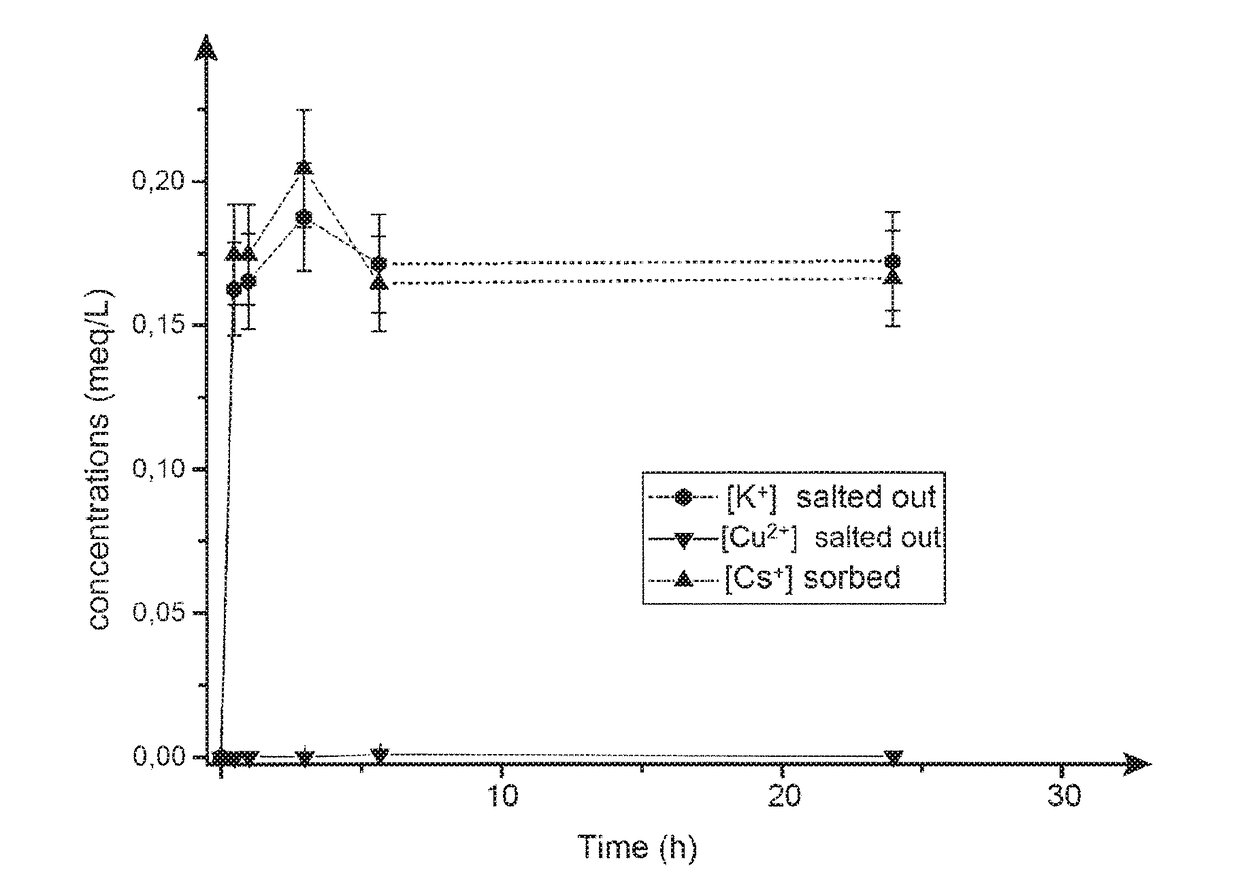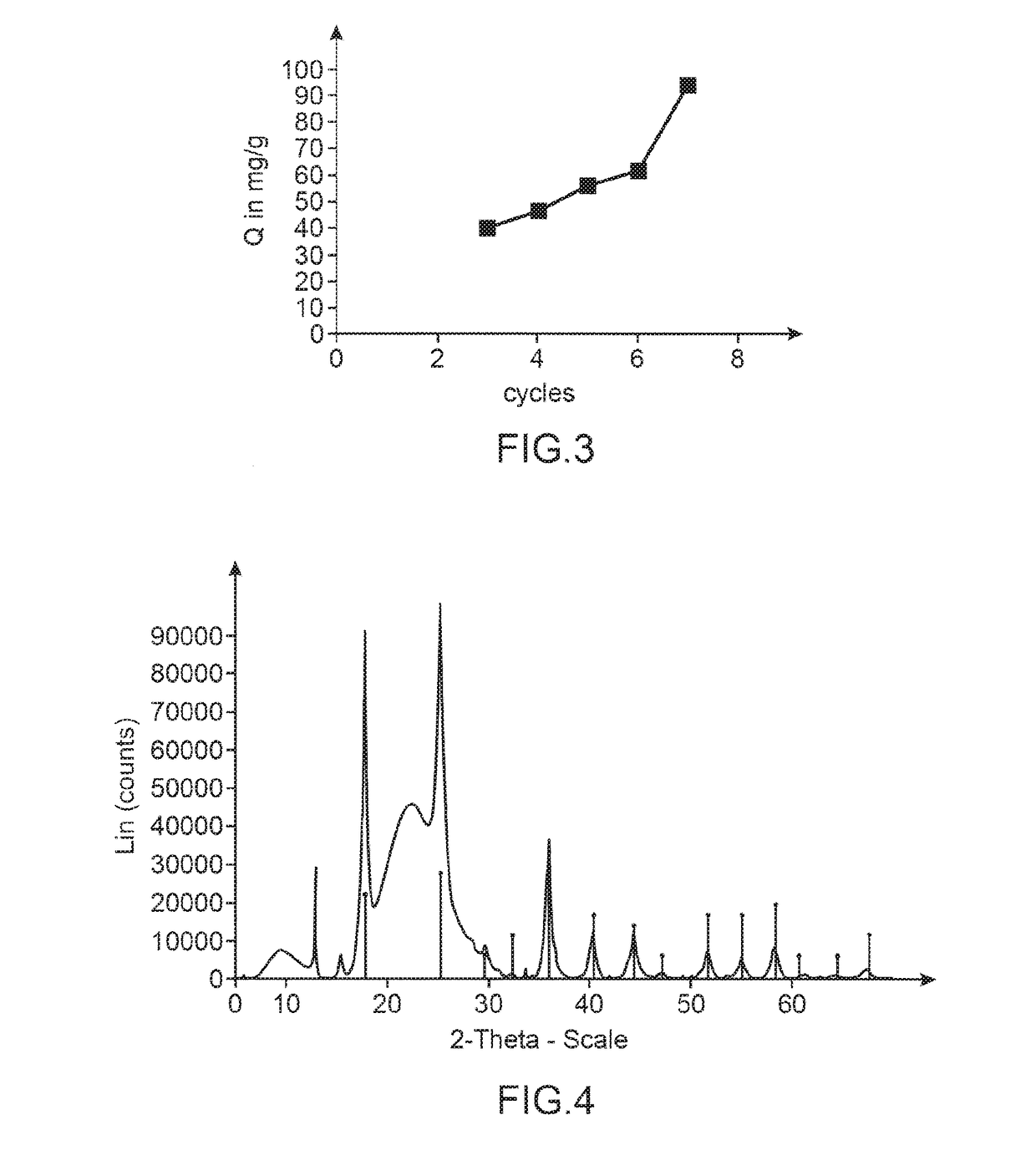Method for producing a solid nanocomposite material based on hexa- and octa-cyanometallates of alkali metals
a technology of hexacyanometallates and nanocomposite materials, which is applied in the direction of ion-exchangers, nuclear engineering, transportation and packaging, etc., can solve the problems of limited capacity, deterioration of resins, and relatively complex synthesis methods described in document wo-a1-2010/133689 [1] to achieve better extraction capacity
- Summary
- Abstract
- Description
- Claims
- Application Information
AI Technical Summary
Benefits of technology
Problems solved by technology
Method used
Image
Examples
example 1
[0248]In this example, the method according to the invention is applied with a support which is a porous glass and an organic ligand which is a diamine.
[0249]The support for grafting an analogue of Prussian blue is a commercial porous glass (TRISPOR®), as granules with a grain size of 200-500 μm, with a pore size of 30 nm and having a specific surface area of the order of 130 m2 / g.
[0250]The operating mode for inserting Copper-Potassium ferrocyanide (K2Cu(Fe(CN)6)) within this porous glass is the following:
[0251]1. Grafting of the Organic Ligand, Graft: R1-(CH2)p—R2.
[0252]The Ligand used for this step (step b) of the method according to the invention) and in this example is 2-aminoethyl-3 aminopropyl-trimethoxysilane marketed by ABCR (but many other suppliers exist).[0253]CAS number: 1760-24-03.[0254]Molecular formula: 3(CH3O)Si(CH2)3NH(CH2)2NH2.[0255]Molar mass: 222.36 g / mol.[0256]Structural formula:
Here, R1 corresponds to trimethoxysilane, while R2 corresponds to the diamine group....
example 2
[0272]In this Example, the method according to the invention is applied with a support which is a commercial silica gel already provided with amine functions by grafting of a ligand.
[0273]This silica gel is available from Sigma Aldrich® and has the following properties:[0274]Pore size=60 Å.[0275]Particle size: 40 to 63 μm.[0276]Specific surface area: 550 m2 / g.[0277][NH2]=1 mmol / g i.e. 9%.
[0278]Thus, only the impregnation step is required, but the cost of the synthesis is much greater because of the high cost of the support.
[0279]The impregnation cycle with copper-potassium ferrocyanide is accomplished under the same conditions as in example 1 i.e. in a “batch” mode, or in a “column” mode.
[0280]The Cs extraction tests are also accomplished under the same conditions as for Example 1.
[0281]Effect of the Impregnation Mode: “Batch” Mode or “Column” Mode.
[0282]The results obtained are compared in terms of cesium adsorption capacity with the material prepared as described above by a method...
PUM
| Property | Measurement | Unit |
|---|---|---|
| Grain size | aaaaa | aaaaa |
| Grain size | aaaaa | aaaaa |
| Diameter | aaaaa | aaaaa |
Abstract
Description
Claims
Application Information
 Login to View More
Login to View More - R&D
- Intellectual Property
- Life Sciences
- Materials
- Tech Scout
- Unparalleled Data Quality
- Higher Quality Content
- 60% Fewer Hallucinations
Browse by: Latest US Patents, China's latest patents, Technical Efficacy Thesaurus, Application Domain, Technology Topic, Popular Technical Reports.
© 2025 PatSnap. All rights reserved.Legal|Privacy policy|Modern Slavery Act Transparency Statement|Sitemap|About US| Contact US: help@patsnap.com



